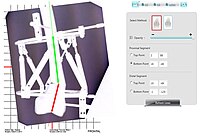
Photo from wikipedia
Computer-assisted navigation systems (CAS) are increasingly being integrated into total knee arthroplasty (TKA) procedures, but perceptions of associated learning curve and increased operative time continue to curtail uptake. Newer-generation navigational… Click to show full abstract
Computer-assisted navigation systems (CAS) are increasingly being integrated into total knee arthroplasty (TKA) procedures, but perceptions of associated learning curve and increased operative time continue to curtail uptake. Newer-generation navigational systems aim to streamline integration into surgical workflow to mitigate increases in operative time. Here, we assess the impact of a novel imageless CAS on operative time for TKA. A retrospective analysis of prospectively collected data of a cohort of patients undergoing primary unilateral TKA with one of three surgeons between October 2019 and March 2020 was conducted. Consecutive cases using a novel imageless CAS were included in analysis. For each surgeon, average operative time was recorded and compared in sequential five-case cohorts to average operative time for the same procedure performed conventionally using a two-tailed t test. Average conventional operative times were 95.9 ± 15.0, 86.6 ± 13.7, and 116.9 ± 25.1 min for the three surgeons. Initial CAS-assisted operative times increased to 107.0 ± 9.8 (p = 0.07) and 102.4 ± 13.2 (p = 0.06) min for Surgeons 1 and 2 and decreased to 113.2 ± 9.8 min (p = 0.52) for Surgeon 3. Most recent CAS-assisted operative times were 94.8 ± 13.9 (p = 0.88), 88.7 ± 15.3 (p = 0.84), and 104.8 ± 13.2 (p = 0.12) min as compared to pre-CAS. Absolute differences for the most recent navigated procedures ranged from 12.1 min faster to 2.0 min slower. The learning curve for TKA navigation may be as few as 10 cases, and any associated increases in operative time may be transient and non-significant. Moreover, navigation may ultimately speed operative time, perhaps as the result of enhanced intraoperative assessment of alignment.
Journal Title: Archives of Orthopaedic and Trauma Surgery
Year Published: 2022
Link to full text (if available)
Share on Social Media: Sign Up to like & get
recommendations!